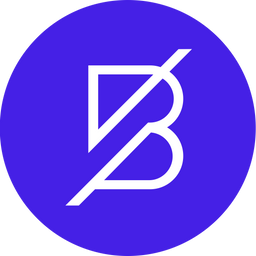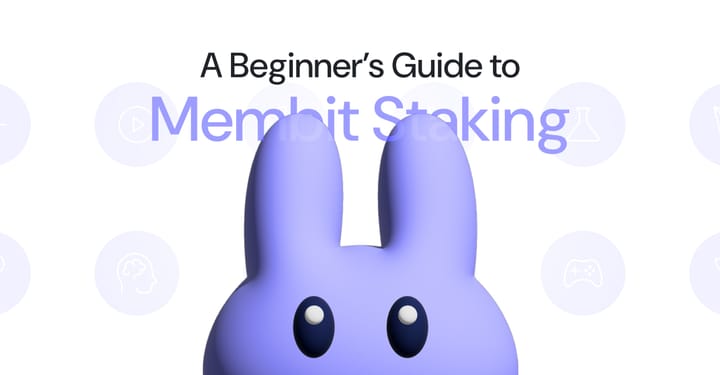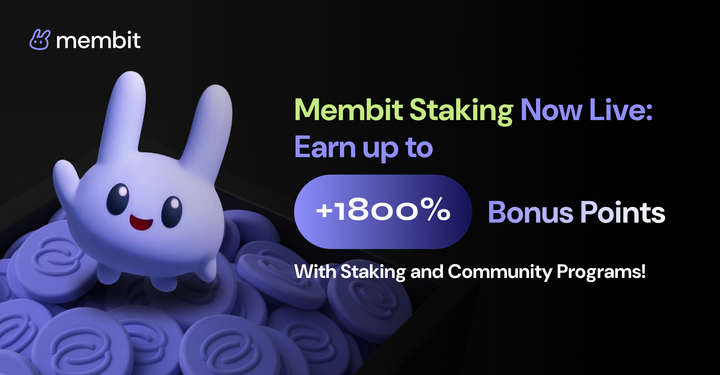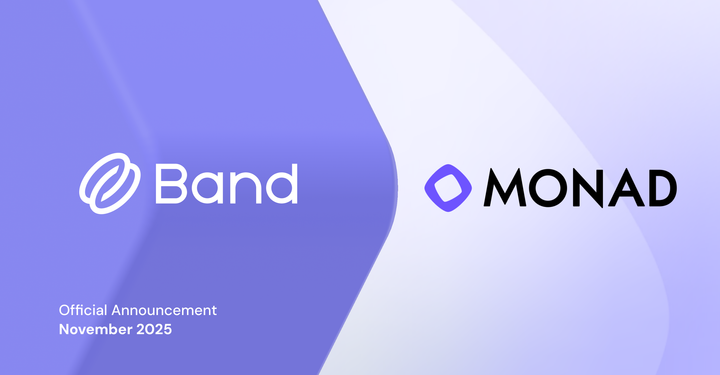AMA Recap: Band Protocol x Oasis Network; Confidentiality, Crypto, and AI
In the world of blockchain, there's a growing need for secure and confidential transactions. This AMA recap dives into a conversation between Leon, from Band Protocol, and William Wendt, from Oasis Network.
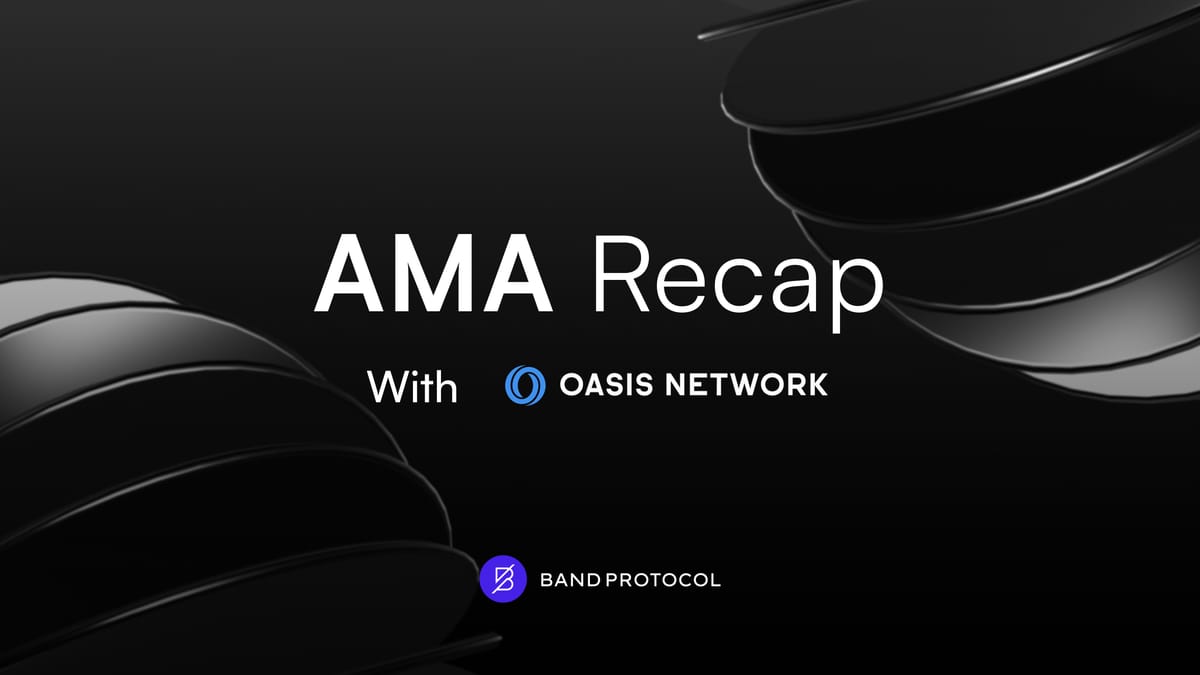
In the world of blockchain, there's a growing need for secure and confidential transactions. This AMA recap dives into a conversation between Leon, from Band Protocol, and William Wendt, from Oasis Network. The discussion is on the topic of how Oasis Network's confidential computing technology can address privacy concerns in blockchain applications. The conversation also explores the integration between Band Protocol and Oasis Network, which brings secure oracle data to the Oasis Sapphire network and the perspective on crypto and AI.
*** Some parts of the following transcript have been edited for clarity while ensuring the original meaning is preserved.***
Leon: For the people that do not know what Oasis Network essentially is, mind giving everyone a quick TLDR on what you guys are doing and what the vision is here?
William Wendt:
The Sapphire network, Oasis Sapphire is the first ever confidentially enabled EVM. So that means you can have smart contracts on Oasis Sapphire that have, an encrypted smart contract state. And, we've learned that it's like an abstract term to most Web 3 users, just because no other network has it. But, what it means is that these contracts that can have an encrypted state can span the spectrum of confidentiality. So they can be entirely transparent. They can be entirely anonymous, or they can be the entire spectrum in between. And so that enables things like illumineX, our first DEX, which can swap tokens privately. So, now you have a DEX that operates in a way where your neighbors can't see your positions. We'll have other protocols like the Mirage money market coming soon, with confidential lending.
So, people can't see your positions and won't know your liquidation prices to snipe them. That's what you can do in DeFi and gaming. If you think about traditional gaming or web 2 gaming, almost every single aspect will have confidential logic. A card game will have where you can't know what other cards the other player is holding. You can't know what cards are coming next in the deck. A strategy game has this idea of a fog of war, like a role-playing game. It has quests, riddles, puzzles, things of that nature. All of these things can't be put on chain today, on other networks, because you'd be able to read them entirely on chain, and then the game wouldn't function. But on the Sapphire, you actually can. So that's the massive breakthrough in Web 3 there.
Leon: The Oasis Network is well known for being able to keep data private and its confidential computing platform. Some people might think that your platform token with that, Rose, is a privacy coin, this however is not the case in my understanding. Can you explain a bit more about this topic?
William Wendt:
Privacy is not about whether you can have anonymous transactions or not like on Zcash and Monero. How I would describe Oasis is this. If Monero is a private Bitcoin, Oasis is confidential or private Ethereum. We focus on the computation and the confidential state where you can build DEXs, lending protocols, and games, which leverage confidential lock. And, you can add encryption to the gaming or the dApps ecosystem. Of course, you could build transactional privacy. You could wrap any ERC-20 token in a privacy wrapper, and, then, you have these private transactions. But, in actuality, as I said earlier, the network spends the entire spectrum from entirely transparent to entirely confidential and everywhere in between. And so, Rose is transparent by default on our network. And, that's how the Oasis Protocol Foundation intends to use Rose. It's an open ecosystem. So, if someone wants to build a wrapper and add privacy to it, they can. Rose is just the sort of gas token that powers our ecosystem, and it's entirely transparent. The dApps that are built that leverage that gas, can leverage encryption as they choose.
Leon: When reading through your docs I noticed that Oasis Sapphire has 99.9% less fees than Ethereum, would you mind explaining how this is achieved?
William Wendt:
We have a mock architecture, similar to Cosmos, which I believe Band is based on, or similar to how Ethereum/ Ethereum 2.0 was constructed. We have an underlying consensus layer. Then on top of that, we have execution layers, which we call Para Times stand for parallel runtimes. It's a product that we were a bit early to this because you could think of them as Layer 2 or roll-ups. That phrase hasn't been coined yet. But It’s the idea of execution layers, whether it be Oasis Sapphire, Oasis Emerald, or some of the work we're doing now with DeltaDAO or Cipher. They will have to do the execution and then submit a bare metal proof to our consensus layer for validation. So this is pretty similar to how the current modular architecture works, except for Ethereum you have a lot of this technical debt.
It wasn't necessarily designed with this modularity in mind. So there's a lot of technical debt there. With the Oasis network, we always plan to have this modular architecture. So, our consensus layer can only handle staking and then transfers of ROSE, and I think delegation and voting. So there's no reliability on the execution layer to build smart contracts. This is the modularity, separation of execution, and consensus, and that's a big reason why we're able to achieve the massively greater fees because just basically validation on the consensus layer is super cheap.
Leon: Let’s dive a bit deeper into the formal partnership we have between Band Protocol and the Oasis Network. Could you enlighten me on the long-lasting partnership we have here and why it benefits Oasis as a whole?
William Wendt:
I think Band, when I started I don't even know if I was part-time at Oasis. The Band Protocol team was one of the first, sort of, teams that I have ever talked to. Again, like I said, I came into crypto through Oracles. For the Emerald ecosystem we understood that if we wanted to build a gaming ecosystem, if we wanted to build, a DeFi ecosystem, we would need price feeds. (Details about our initial integration with Oasis Network can be found here: Link)
And, Band, like you said, was one of the top 2 Oracle providers. And, we got integrated super quickly. That was the beginning of a great relationship. It helps to power a lot of dApps on Oasis Emerald, including BC Finance, Fountain Protocol, and others. Any developer that was working with you guys, had nothing but nice things to say. So, of course, when it came time for Oasis Sapphire, we reached out to Band again, and we got integrated.
And, the Band team did a great job of handling the minor changes that have to occur to integrate a confidential ecosystem. So we've been on the testnet for a while waiting for the needs of the system to need the price feeds. And then recently with Vine protocol, Mirage Money Market coming up, and a few others that are starting to build on the ecosystem. They're all gonna need price feeds, and so, it became time to get Band on mainnet.
Again, you guys have been great. You guys move super quickly with that. And so far so good. Again, everyone's saying nothing but nice things about the integrations, and we look forward to having you integrated more, getting more price feeds online, and so on as the ecosystem expands. And, that's that's a bit about where we've been and where we're going.
Leon: Moving back to the Oasis Network. What is the Oasis Privacy Layer, OPL, and why OPL?
William Wendt:
It's this idea of using a cross-chain to make OASIS Sapphire be sort of L2 or sidechain where you can offload your confidential computation needs. In some ways, you can think of it as playing like a confidential Oracle. Not really for off-chain data, but for sending the results of confidential computation that you need, to happen on chain from different chains. Something that you can think about is the example I gave with gaming.
Let's look at a DeFi example. Centr is doing this thing where deposit collateral is on Ethereum. Then, you can mint the synthetic asset on Oasis Sapphire or any of the other ecosystems within their protocol. They'll need price feeds to determine what you have to pay back as well as what your liquidation prices are and things of that nature. That's one area where Band comes into play. Where Opal will come into play will be the ability to keep those positions. If you deposit on OASIS Sapphire, you'll be able to keep the collateral that you use and what synthetic assets you mint, entirely confidential, meaning that traditional market players and whales can hide what positions they have long. But, again, they'll have the ability to deposit on one chain and then mint on Oasis Sapphire using cross-chain messaging.
So these are the types of ideas that OPL enables, Illuminex, which is our confidential DEX, which I mentioned before, and it enables cross-chain swaps. You can swap from, ETH on Ethereum to BNB on Binance Smart Chain through the OASIS Sapphire network, and then it will be entirely confidential on the other side. I think Mirage Money Markets also intends to do this cross-chain lending. So, the way I define Opal is this. It is the ability to take what Oasis Sapphire offers natively, and then integrate it into other ecosystems.
Leon: There is a very hot topic that’s been emerging over my feeds the past weeks, has been AI & crypto, I know that over at Band we have a proposal running right now to integrate AI-generated Oracle data. How is Oasis focussed on this matter regarding AI and crypto? If I recall correctly you guys had a partnership with META AI a year ago or so.
William Wendt:
AI is an interesting topic in crypto. Because, on one hand, the computation side is, it is hard to integrate with crypto because crypto is moving a little bit too slowly for AI computation. It doesn't have the bandwidth, but there are also a lot of other interesting things to do.
So, we're focused obviously on the confidentiality aspect of AI, which is that. Our founder, Dawn Song, showed in a lot of papers back in early 2000 that data can be leaked through AI models. So a lot of the work that Oasis Labs is doing, which is a separate entity from the foundation, but we do work closely together.
A lot of the work that Labs is doing is, around sort of this doing confidential or encrypted, off-chain compute, which then sends validations to Sapphire, or you use cryptography to ensure that this encryption and these calculations won't leak any personal information or confidential data or leak the AI model itself, which is important for these AI companies.
So, Labs is working with Meta. They also are working with a few other large enterprise partners. BMW is a major partner right now, but on that side of things, it generally moves very slowly with these Fortune 500 companies. They're pretty cautious as well as AI is only one of the small things they're working on versus a product that is just AI-focused.
On Web 3, we integrated Ocean, where Ocean builds its predictor dApp on top of OASIS Sapphire. They did that because, essentially, they researched all the other privacy technologies, and we were the only ones who fit their needs, for confidential computation. But, the predictor app uses AI models to predict, it's sort of like a price feed, but it's not. It's as if Band is, telling you what the current price is, Ocean is creating an AI model for what future prices are. So I guess a future oracle or something like that, where you can build subscriptions on and things of that nature.
In the future, I'd love to see weather predictor predictions for future weather data and stuff like that for insurance products. They're using AI, and they're using OASIS to keep the algorithms, as well as, what people staking, as well as what the result of the computation is, private except for to our or paying for the subscription. So that's one end of things. And then Delta DAO, we just started a recent partnership as well. But they're in the AI and data space and looking to build their dApps on Sapphire as well.
And I think we go very hand in hand in the sense that, for these models, they need confidentiality. And currently, I think we're probably the only network that is easy right now. I know there are other privacy providers, but it's super, at least developers have told us that it's a lot more comfortable for them when they get to use solidity and that all the tools that they have in the EVM that have been over the last 8 years versus having to learn some new language, and or build new tools, like wallets and explorers. They get that all out of the box with OASIS Sapphire.
Leon: What is there to look out for in 2024 for the Oasis Network, you guys have been ramping up partnerships and any cool things to look out for for Oasis? What is the roadmap for this year?
William Wendt:
I think, so for me, I focus a lot on the ecosystem roadmap. It's all about getting, like, the basic cornerstones of our ecosystem to set up and all the plumbing, which is Oracles. It's indexers. It's RPC gateways. I think we have pretty much all the plumbing there. Now we just need to finish up a few corners. So we have our decks. We have a stablecoin.
Now, we need lending, in which 2 different lending protocols are going to launch in the coming months. I think we need a launch pad. We have our NFT marketplace with that. So, I would say the things that we still need to get completed are lending, synthetic assets, and a launch pad. We're putting a lot of energy and effort into those things, and then we're also looking at verticals like gaming. Polychain Monsters just built the first-ever game that leverages confidentiality on-chain logic. So, I think there is gonna be a tournament to help demonstrate that use case and how simple it is to play a game on Oasis Sapphire that leverages these features, and we'll try to look at these verticals and expand them as well. That's on the ecosystem side for me.
Another interesting thing that we're trying to do is we're trying to integrate community grants. We wanna have the smaller grants, like, the 5 to 10k grants, completely run by the community where the community can vote, and decide whether grants where grants are offered and things of that nature. Those are the 2 major sorts of BD or ecosystem road maps. Then, there are a lot of, like, engineering items, including, adding Bitcoin-like clients to validators, and Ethereum-like clients to validators on always Sapphire.
This will help a lot with caution communication in the sense that, basically, instead of sending messages from Ethereum to Oasis Sapphire, Oasis Sapphire will just be reading it. We'll just be able to see event emissions, which will help massively in sort of the Opal space. And then also interpretive communication is also on the agenda. And then, I think about a few other proof of concepts and the account abstraction & smart accounting space. I think, for the next several months, we will have at least one conference a month.
So, we're going pretty hard this year, and I think it's the right time to do so. There is a lot of consensuses that we're back in the bull. I think no one is ever able to tell, but at least the hype is starting to pick up. Privacy is one of the trending topics, and we're in the right place at the right time right now, and we're trying to capitalize on that by building a robust ecosystem, which our users can enjoy.
Conclusion
This AMA recap offered valuable insights into Oasis Network's approach to privacy in blockchain. William Wendt highlighted the potential of confidential computing for various applications, including DeFi, gaming, and AI. The integration with Band Protocol further strengthens Oasis Network's ability to provide developers with the tools they need to build secure and private blockchain applications. With a focus on ecosystem development and upcoming features like lending and synthetic assets, Oasis Network is well-positioned to capitalize on the growing demand for privacy in the blockchain space.
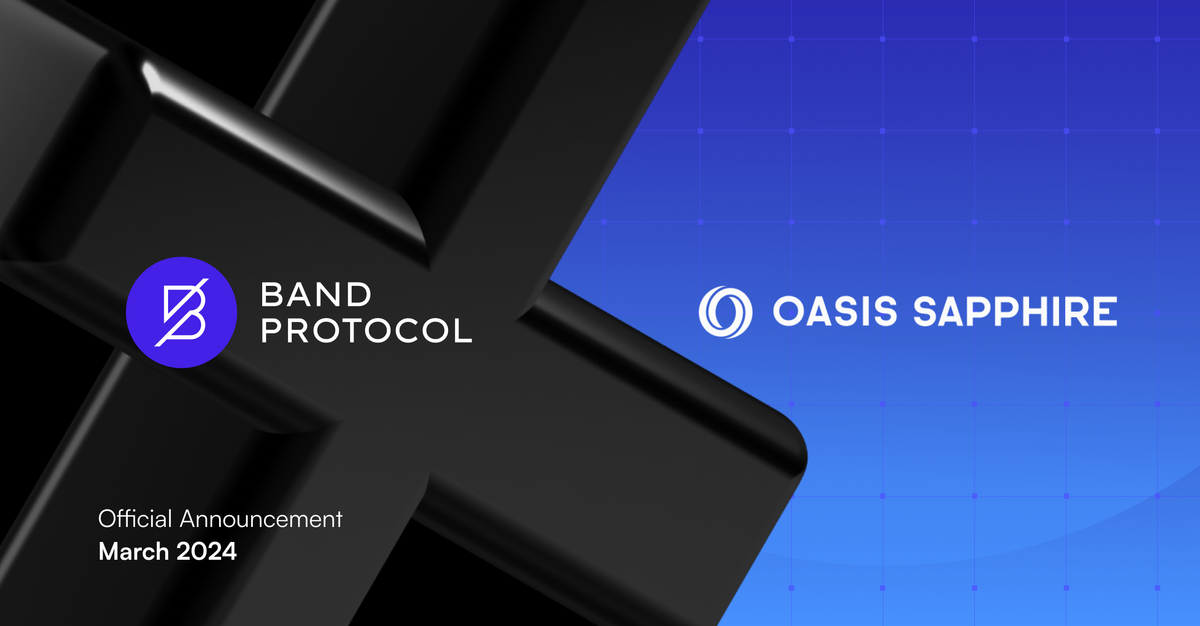
About Oasis Network
The Oasis Network is the pioneering layer 1 blockchain designed to enable scalability and confidential computing. Oasis is home to Sapphire, the first confidential EVM that empowers Web3 developers to build dApps with Smart Privacy, both natively on Oasis or other EVM-based chains.More about Oasis Network: Website | Twitter | Discord | Telegram
About Band Protocol
Band Protocol is a cross-chain data oracle platform with the aspiration to build high-quality suites of web3 development products. The flagship Oracle solution aggregates and connects real-world data and APIs to smart contracts, enabling smart contract applications such as DeFi, prediction markets, and games to be built on-chain without relying on the single point of failure of a centralized oracle.
More about Band Protocol: Linktree

